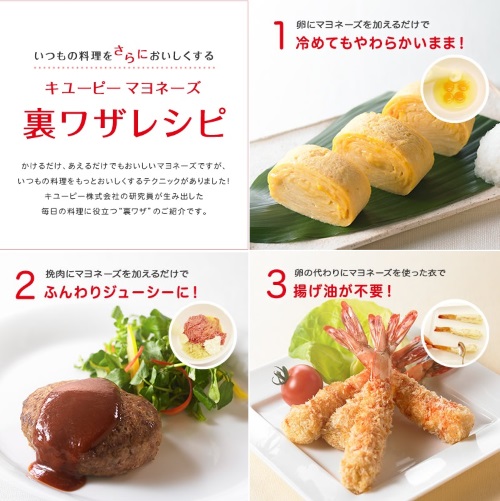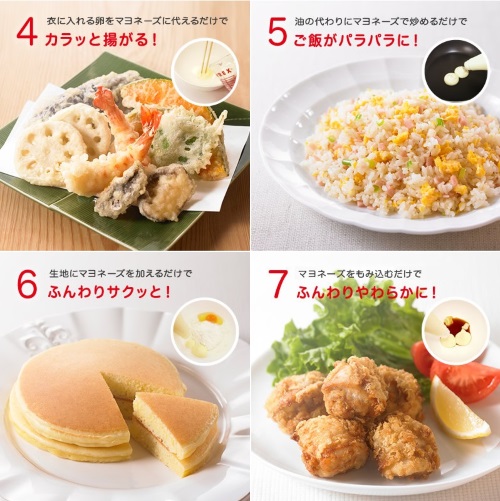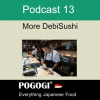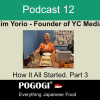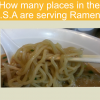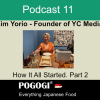How Do People In Japan Use Kewpie Mayo?
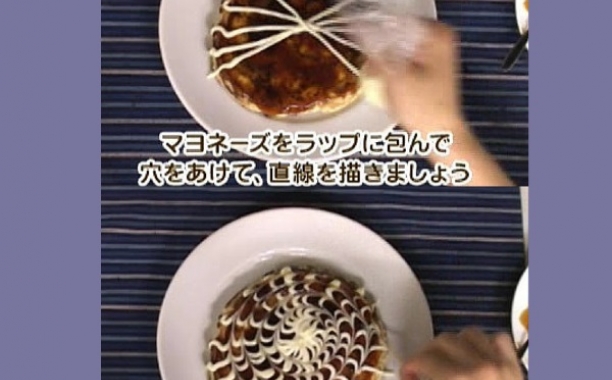
With the ever popular Kewpie's Japanese Mayo(more info) growing worldwide, the question comes down a lot on how Japan uses Mayo.
In western countries, mayonnaise is used mostly as a sauce in sandwiches and is an important ingredient for making potato and tuna salad. In Japan it is used on much more foods and even on traditional foods such as:
1. Okonomiyaki (vegetables, meat and batter shaped like a pancake),
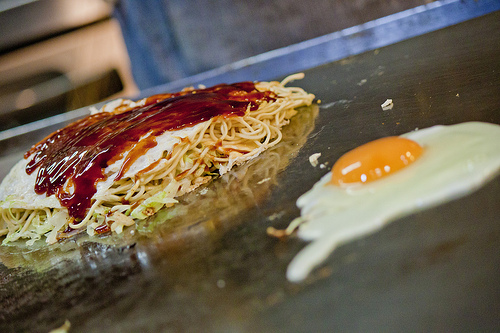
 by terrykimura
by terrykimura
2. Yakisoba (stir-fried noodles) - Mayonnaise is squirted on top of yakisoba as a finishing touch
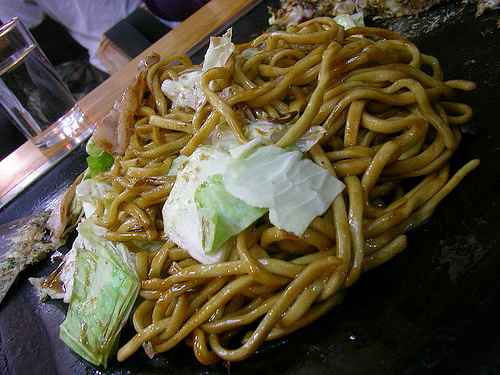
 by jetalone
by jetalone
3. Takoyaki (octopus in batter and shaped into balls) also absorb copious amounts of oil as they cook and yet the Japanese garnish these with mayonnaise. Some takoyaki chains even have their own special secret mix of mayonnaise.
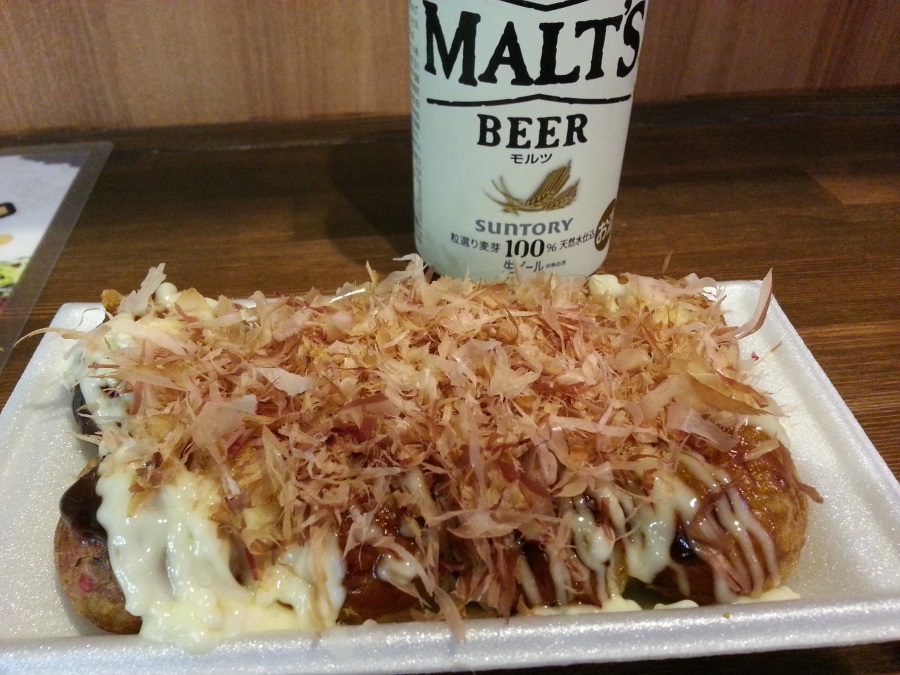
Okonomiyaki is probably the most famous out of the 3 mentioned above and it is popular for be decorated in a fancy way with Mayo. Here an artistic marbling of dark okonomiyaki sauce.
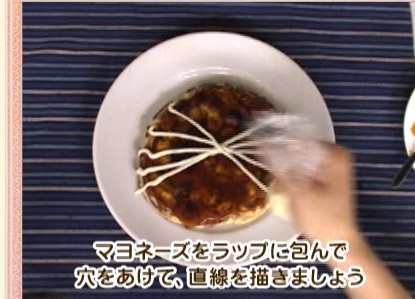
Okonomiyaki decorated with more Kewpie Mayo.
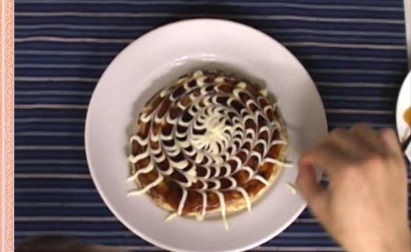
Here are a listing of non-tradtional food that Japan puts mayo on.
Salad
Like other mayonnaise-loving people elsewhere, the Japanese also like mayonnaise in their salad dressings.
It’s quite rare to have a salad simply dressed in mayonnaise though, so other ingredients such as wasabi, soy sauce, yuzu, sesame seeds, spicy fish roe, ponzu, or ketchup are added.
Fruit Salad
But vegetables aren’t the only salad ingredients dressed in mayonnaise-based dressings - “fruit salad mayonnaise” is also favored with banana, apple, strawberry, kiwi, mayonnaise and cream or yogurt as its most popular ingredients.
Sandwiches
Another familiar use of mayonnaise is in sandwiches but as in salads, mayonnaise is seldom used alone.
It is often mixed with either butter/margarine or mustard. Favorite sandwich fillings are slices of ham with mayonnaise and butter, mashed hard-boiled egg with mayonnaise and mashed canned tuna mixed with mayonnaise.
So really no different than how people use it in North America and Europe.
Rice Ball
Tuna and mayonnaise is a beloved combination, in fact, the best-selling onigiri (rice ball) in convenience stores is “tuna mayo.”
Sushi
A popular product among kids is “tuna mayo maki”, which is simply a sushi roll with a tuna mayo filling. Shrimp mixed with mayonnaise or “ebi mayo” is also popular.
Ebi mayo isn’t limited to sushi. It is also the name of a dish that features fried shrimp coated in mayonnaise and served with shredded cabbage or lettuce.
The mayonnaise is often mixed with ketchup, but there are versions containing sweet chili sauce or Dijon mustard. Strangely, it doesn’t feel greasy - the tangy taste of Japanese mayonnaise and the ketchup cuts through the oil.
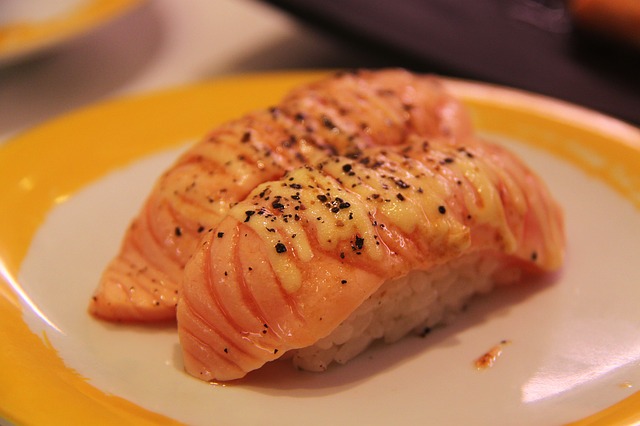
Furai
It may be counterintuitive to pair fried food and mayonnaise but as the main ingredient of tartar sauce, mayonnaise goes well with furai (fried seafood or vegetables) and katsu (fried cutlets of meat). As with ketchup in ebi mayo, the onions in the tartar sauce cut through the grease.
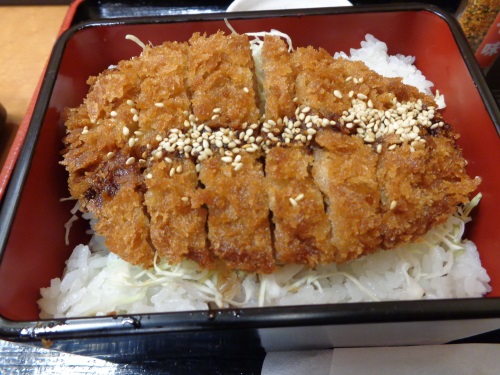
Other Dishes
Aside from these Japanese “soul foods,” mayonnaise is also used in more familiar comfort food such as gratin and potato salad. Japanese gratin is usually a dish of macaroni with bechamel sauce, but mayo gratin can be anything with a bechamel-mayonnaise sauce. On the other hand, Japanese potato salad will almost always feature mashed potatoes, sliced cucumbers and carrots, ham and mayonnaise.
Kewpie Recommendations
(numbers corresponds to image below):
There are other uses for mayonnaise in Japan. Kewpie’s website suggests coating raw shrimp with panko (breadcrumbs) and mayonnaise(3), and cooking these in an oven toaster for a quick ebi furai (fried shrimp).
It also encourages the use of mayonnaise in place of oil when making fried rice(5). It even recommends adding it to pancake mix for fluffier pancakes (6)! The obsession with mayonnaise doesn’t stop there - Ajinomoto, which makes the second best-selling mayonnaise even has a “mayonnaise decorating” contest where food becomes the canvas for mayonnaise lines and swirls.
